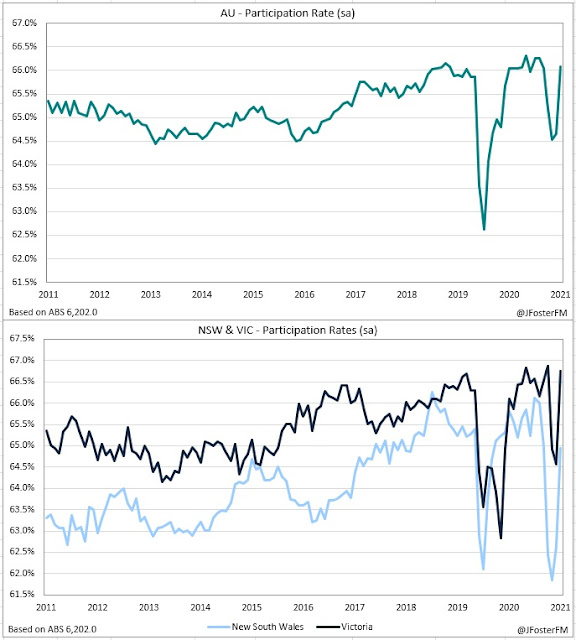The hit to the Australian labour market from the Delta lockdowns was cast aside in November as employment and hours worked more than rebounded from the declines seen over the winter and early spring. Unemployment and participation returned to their pre-Delta levels ahead of what is shaping up to be a strong economic recovery into 2022.
Labour Force Survey — November | By the numbers
- Employment (on net) increased by a record 366.1k in November, coming in significantly above consensus for a 200k rise. October's decline was revised to show a larger fall of -56k from -46.3k previously.
- Headline unemployment fell to 4.6% (vs 5.0% expected) from 5.2% in October.
- Labour force participation returned to its pre-Delta level as it rebounded from 64.7% to 66.1%.
- Hours worked surged by 4.5% in the month to be 2.7% higher over the year.
Labour Force Survey — November | The details
Australia's labour market is rebounding at a rapid pace from the recent Delta lockdowns seen across large parts of the nation. November's rise in employment of 366.1k was a record increase and more than restored the decline of around 360k seen over the course of the lockdowns. Key contributors were the states coming out of lockdown, with New South Wales +179.8k and Victoria +141k. Overall, Australian employment has rebounded to be 1.4% above its pre-pandemic level. Meanwhile, with employment surging and restrictions on businesses easing, hours worked lifted by 4.5% in the month, driving it back up to 2.0% above its pre-pandemic level.
November's employment outcome incorporated a 237.8k rise in part time employment and a 128.3k increase in the full time segment. Overall, full-time employment is 2.1% above its pre-pandemic level but the part-time segment is significantly lagging at -0.1%, with the disparity reflecting the much larger hit to the latter during the recent lockdowns.
Between May and October, total hours worked contracted by around 5% on the back of the lockdowns and associated restrictions. In November alone, hours worked rebounded by 4.5%. part-time hours soared by 8.5%m/m while full-time hours increased by 3.6%m/m.
Hours worked in Victoria rebounded by 9.7%m/m to be 1.6% higher than their pre-pandemic level. New South Wales saw a larger hit to hours worked during its recent lockdown compared to Victoria. Even after a further rise 5.6% in November following gains of 2.7% and 3.8% in the previous two months, hours worked in New South Wales are only now back at pre-pandemic levels. Total hours worked across all other states and territories remain elevated at 3.8% above pre-pandemic levels.
Encouragingly, participation levels have rebounded sharply since the lockdowns were lifted. Australia's participation rate (66.1%) is broadly back to the levels seen prior to the Delta setback. Victoria (66.8%) has led the way, though New South Wales (64.9%) still has some way to go in getting back to pre-Delta levels (around 66%).
Measures of labour market spare capacity were on the rise during the lockdowns reflecting the loss of employment and hours worked. The reopening in November drove a sharp reversal in this trend. Unemployment fell to 4.6% from 5.2%; underemployment was down from 9.5% to 7.5% and underutilisation declined 2.6ppts to 12.1%. Underutilisation (including both unemployed and underemployed workers) is now at a 9-year low.
Labour Force Survey — November | Insights
The Australian labour market is back on track rebounding sharply in November from the recent Delta lockdowns. Forward-looking indicators of labour demand are pointing to ongoing strength, with national job vacancies sitting at a very elevated 252k in November according to data out earlier in the week. The snap-back seen in participation suggests there is the supply of labour coming back to meet this demand, albeit with some progress still required in New South Wales. Rising caseloads may present some risk to the near-term momentum, but underlying conditions are very strong.










